
7 Brands That Buy Your Used Clothing
There are now countless ways to live a sustainable and eco-friendly life, and most of us are aware and easily apply some of these things to our daily lives. Things like recycling, reusing, and repurposing have practically become second nature to a lot of us. People are consuming less, and industries are using fewer virgin materials to produce their products.
The apparel industry is one of the most polluting industries in the world. The introduction of fast fashion has frighteningly raised the level of over-consumerism worldwide and filled up landfills with disposable garments at an alarming rate.
Read 10 BEST SUSTAINABLE FASHION BRANDS.
And 10 Best Sustainable Footwear Brands for Older Women
As you begin to expand and explore the ways you can change your consumer habits, your closet is one of the biggest ones to tackle. Thankfully, it is possible to consume less and repurpose your used clothing while still looking good!
Brands That Buy Back Your Used Clothing
- Patagonia – Worn Wear – If you have an old Patagonia item that is just sitting around and in good condition, Worn Wear will give you credit towards your next purchase on a used or new garment.
- Eileen Fisher – Renew – Eileen Fisher RENEW will take your pre-loved Eileen Fisher items back and give you credit towards your future purchases.
- Lululemon – Like New – Lululemon has a shop called Lululemon Like New that offers to trade in your used goods and in return offer credits towards your next new or used Lululemon items.
- Levi’s – Second Hand – Denim giant Levi’s also has a second-hand shop where you can trade in your used Levi’s denim items for gift cards
- REI – Re/Supply – Outdoor gear supplier REI lets you swap your pre-loved items at REI Re/Supply for gift cards to use on your next purchases.
- The North Face – Clothes the Loop – Clothes the Loop program will take your gently used apparel and footwear at one of their stores or outlets and give you a reward on your next purchase.
- Madewell – Madewell Forever – Madewell Forever encourages shoppers to reuse, recirculate, and repeat their clothing.
Thrift shopping, trading, and reselling have become very trendy over the past few years. My 27-year-old daughter and her friends almost exclusively shop at second-hand stores. Not by necessity, but by a conscious decision to consume less, live as sustainably as possible, and also by the curiosity to explore unique vintage fashion finds. They get giddy exchanging their latest finds with each other and enjoy putting together creative outfits.
There is a new trend that is quickly gaining popularity among brands and designers – buyback/trade-in programs. They take back your pre-loved used clothing (their brand) in exchange for credit on your future purchases.
It’s never been easier to live a sustainable lifestyle!
Of course, you won’t get rich trading your used clothing back to their original retailers. Typically, you’ll get shopping credits to use on your next purchase. But to be honest, the simple act of helping to keep clothing out of landfills and living more sustainably is rewarding enough for me!
Why Are Trade-in/Buyback Programs A Good Idea
Trade-in and buyback clothing programs offer several benefits for you, the consumer, and the environment.
Here are some reasons why these programs can be considered a good idea:
Sustainability
One of the primary advantages is environmental sustainability. By encouraging you to trade in or sell your used clothing, these programs extend the lifespan of garments, reducing the overall demand for new production. This helps in minimizing the environmental impact associated with the fashion industry, including resource consumption, pollution, and waste.
Circular Economy
Clothing buyback programs contribute to the development of a circular economy in the fashion industry. Instead of following a linear model of production and disposal, where clothing is made, used, and then discarded, a circular economy emphasizes reuse and recycling. By participating in buyback programs, you can actively engage in this more sustainable approach.
Reduced Waste
Fast fashion and the disposable nature of clothing contribute significantly to textile waste. Trade-in programs help combat this issue by diverting clothing items from landfills. When you trade in your used clothing, it reduces the amount of waste generated, promoting a more responsible approach to consumption.
Financial Incentives
For consumers, trade-in programs can offer financial incentives. You can receive store credit, discounts, or even cash for your used clothing items. This provides an extra motivation for you to declutter your wardrobe and participate in sustainable practices without a significant financial burden.
Access to Affordable Fashion
If you are looking to update your wardrobe on a budget, buying second-hand clothing through trade-in programs can be an affordable option. This democratizes fashion, allowing you to access a variety of styles without necessarily contributing to the demand for new production.
Brand Image
Brands that implement trade-in and buyback programs often enhance their image as environmentally conscious and socially responsible. This can attract environmentally aware consumers who appreciate businesses making efforts to minimize their ecological footprint.
Brands That Buy Your Used Clothing
Each brand has different rules for trading and swapping clothing items. Click the link I added to each brand to find out how to proceed with their individual trading program.
Patagonia
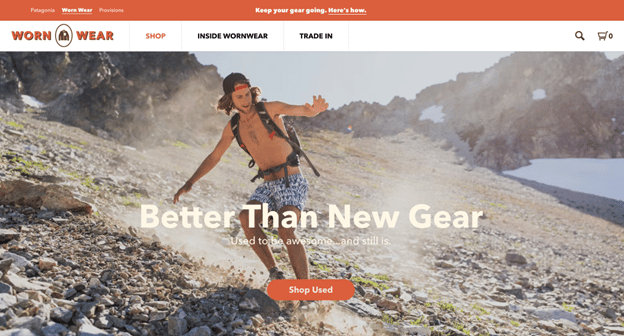
Outdoor apparel giant Patagonia is a pioneer in the buyback and used shop programs. If you have an old Patagonia item that is just sitting around and in good condition, Worn Wear will give you credit towards your next purchase on a used or new garment.
“One of the most responsible things we can do as a company is make high-quality stuff that lasts for years, so you don’t have to buy more of it. Buying used extends a garment’s life by about two years, which drastically reduces both our reliance on virgin resources and our generation of waste.”
—Patagonia
Eileen Fisher

Eileen Fisher RENEW will take your pre-loved Eileen Fisher items back and give you credit towards your future purchases.
“We’re taking our clothes back – over 1.5 million pieces since 2009 – to be resold, donated or remade into new designs. It’s all part of our vision for a future without waste.”
—Eileen Fisher
Lululemon
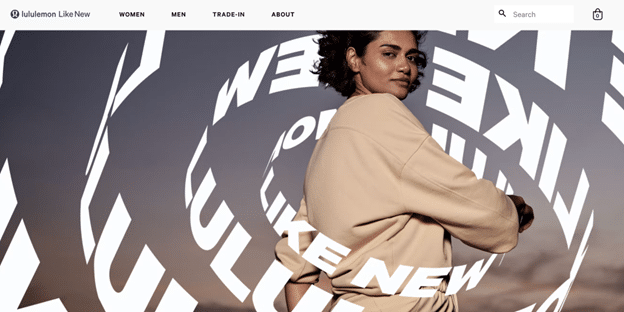
Yoga wear iconic label Lululemon has a shop called Lululemon Like New that offers to trade in your used goods and in return offer credits towards your next new or used Lululemon items.
“We’re taking steps towards a circular ecosystem. When you trade in with Like New or buy refreshed products, you’re helping accelerate our sustainability initiatives. 100% of Lululemon Like New profits will go towards lessening our environmental impact.”
—Lululemon
Levi’s
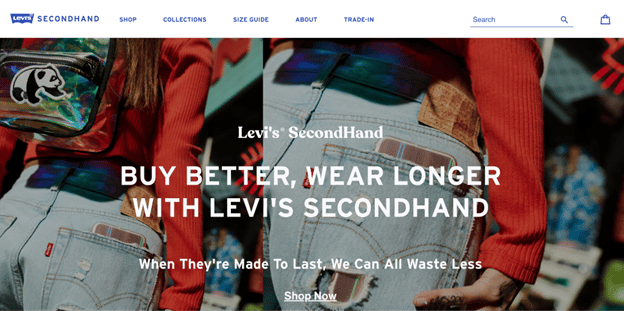
Denim giant Levi’s also has a second-hand shop where you can trade in your used Levi’s denim items for gift cards that you can use in the stores or online; new or used.
“If everybody bought one used item this year, instead of buying new, it would save 449 million pounds of waste.* With Levi’s® SecondHand, we’re inviting you to join us in a more sustainable future.”
—Levi’s
REI
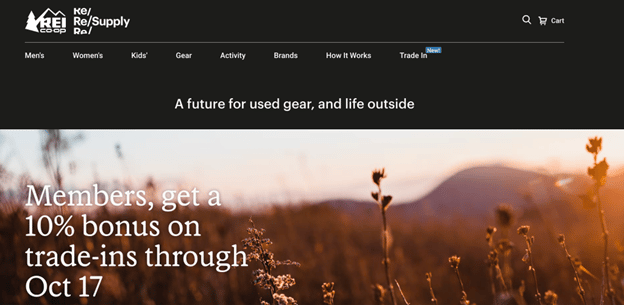
Outdoor gear supplier REI lets you swap your pre-loved items at REI Re/Supply for gift cards to use on your next purchases. Being a COOP, a membership is required to trade and buy used gear and clothing.
“We’re a community of 21 million making a different kind of outdoor company. Built by members, not investors. Accountable to each other, not shareholders. Together, we’re sharing, exploring and protecting the places we love, for today and every day.”
—REI
The North Face

The North Face Clothes the Loop program will take your gently used apparel and footwear at one of their stores or outlets and give you a $10 reward toward your next purchase of $100 or more at The North Face.
“Clothes the Loop stems from our commitment to reduce the environmental impact of our products at all stages of their life cycle, including extending the life of apparel and footwear to keep it out of landfills. Since we started Clothes the Loop, people have brought in more than 95,000 pounds of clothing and footwear to The North Face US stores for reuse and recycling.”
—The North Face
Madewell
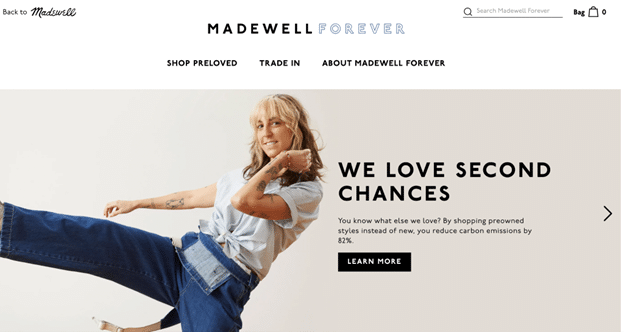
Madewell introduced Madewell Forever and encourages shoppers to reuse, recirculate, and repeat their clothing. Ship your gently used items for free and get shopping credits.
“When you give your clothes a second life, you reduce their environmental impact by 82%.”
—Madewell
Let’s Have a Conversation:
Do you shop second-hand? Have you traded-in clothing items before? Tell us what you think about these initiatives. Will you be trading in your pre-loved goods? Tell us about it in the comments below.






